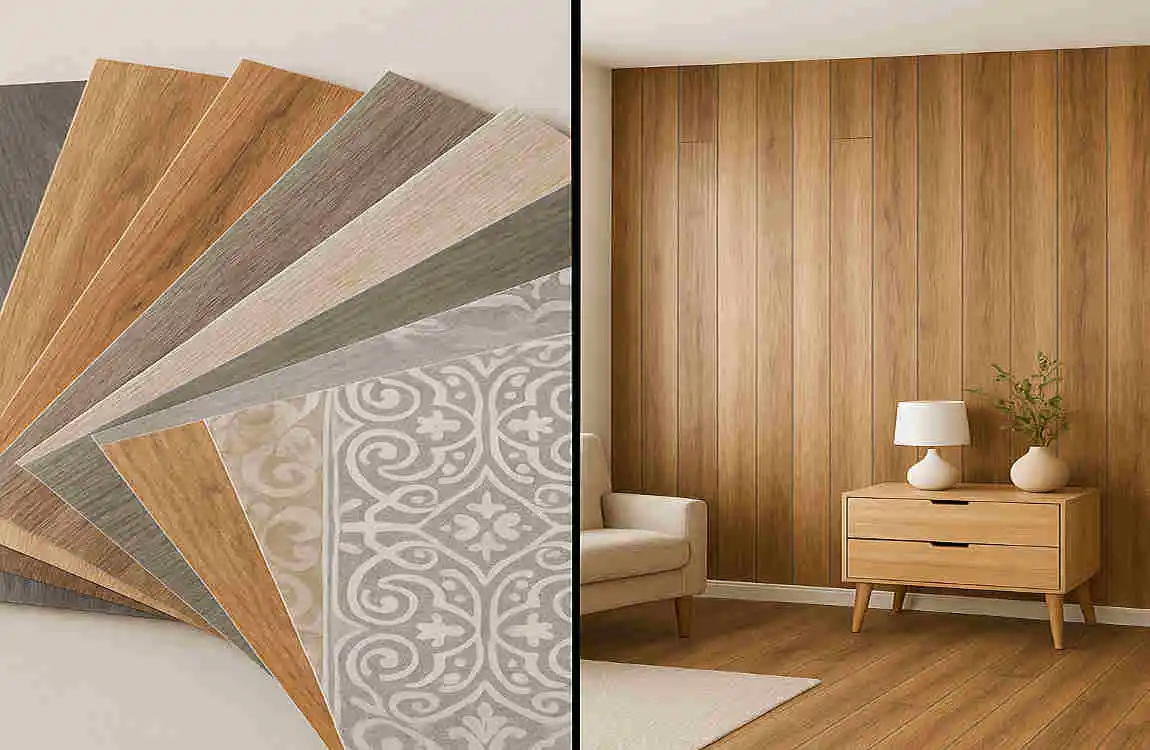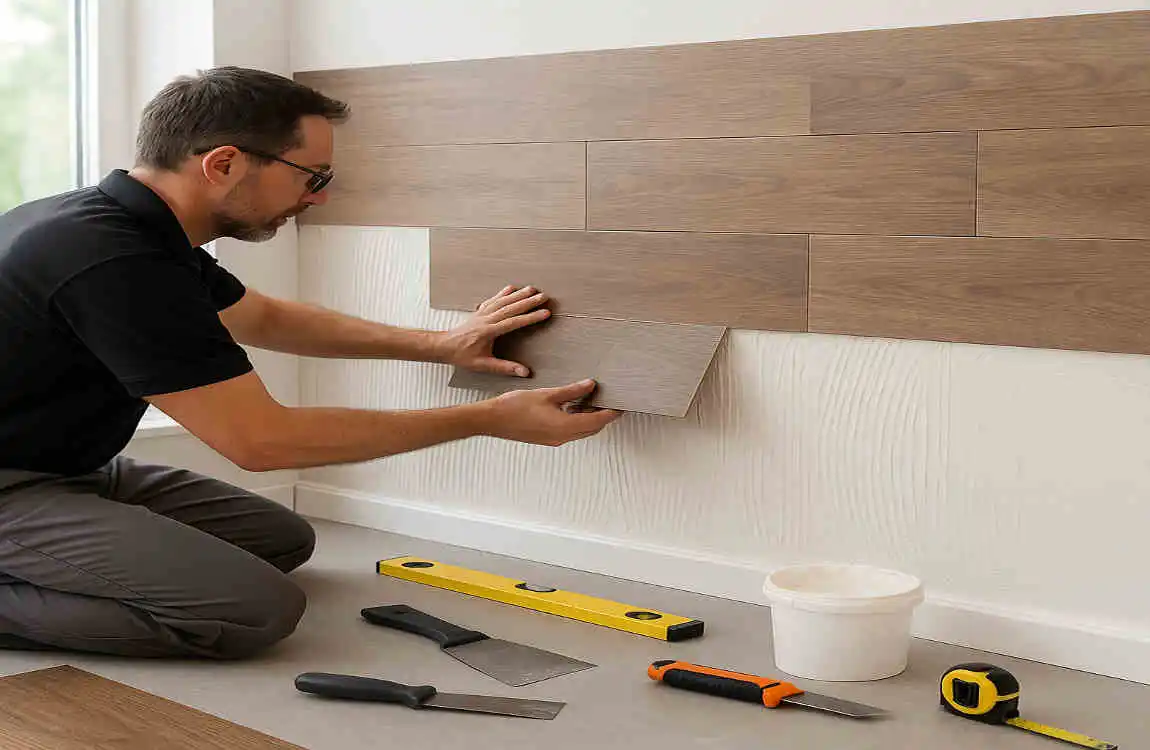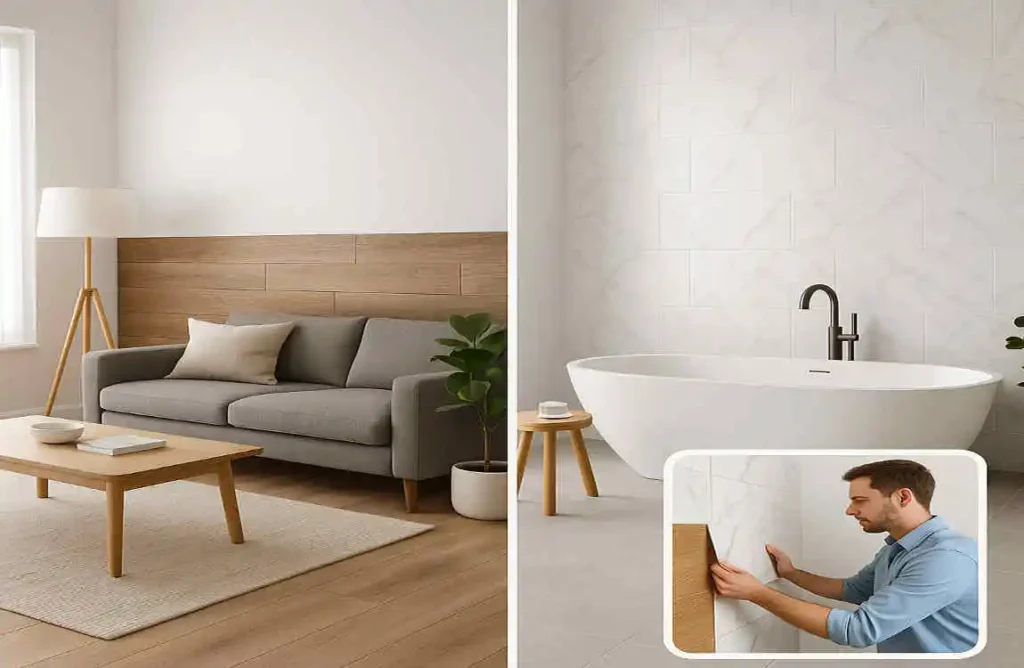Have you ever walked into a room and been captivated by the unique design elements? One trend that’s gaining popularity in the world of interior design is using vinyl flooring on walls. It’s a bold choice that can transform any space into a stunning showcase. But the question on everyone’s mind is, “Can you put vinyl flooring on the walls?”
What is Vinyl Flooring?

Before we delve into the world of vinyl wall cladding, let’s take a moment to understand what vinyl flooring is and why it’s become a popular choice for floors.
Vinyl flooring is a versatile and durable material that comes in various forms, including luxury vinyl plank, vinyl sheet, and vinyl tile. It’s known for its water resistance, low maintenance requirements, and ability to mimic the look of natural materials like wood, stone, and tile. These qualities have made vinyl flooring a go-to option for many homeowners and designers.
But what about using vinyl flooring on walls? Is it possible, and if so, what are the benefits and considerations? Let’s explore these questions in the next section.
Can You Put Vinyl Flooring on Walls? The Basics
The short answer is yes, you can put vinyl flooring on walls! It’s not only feasible but can also create a visually stunning effect in your home. However, there are some essential factors to consider before embarking on this project.
First, it’s crucial to assess the condition of your walls. Vinyl flooring requires a dry, smooth, and clean surface for proper adhesion. If your walls have cracks, holes, or moisture issues, you’ll need to address these before installing vinyl.
When it comes to installing vinyl flooring on walls, there are some differences compared to installing it on floors. For example, you’ll need to use a different type of adhesive, and the installation process may require more precision to ensure a seamless look.
Not all types of vinyl flooring are suitable for walls. Luxury vinyl plank and vinyl tile tend to work best due to their rigidity and ease of installation. Vinyl sheet can also be used, but it may require more careful handling to avoid wrinkles and bubbles.
Benefits of Using Vinyl Flooring on Walls
Now that we’ve established that you can put vinyl flooring on walls, let’s explore the many benefits of this unique design choice.
Unique Aesthetic Appeal
One of the most significant advantages of using vinyl flooring on walls is the unique aesthetic it can create. Vinyl flooring comes in a wide range of patterns, textures, and colors, allowing you to mimic the look of natural materials like wood, stone, and tile. This versatility opens up endless design possibilities, from rustic to modern and everything in between.
Durability and Ease of Cleaning
Vinyl flooring is known for its durability, and this quality extends to its use on walls. Vinyl wall cladding can withstand the wear and tear of daily life, making it an excellent choice for high-traffic areas like entryways and hallways. Additionally, vinyl is easy to clean, requiring only a damp cloth or mop to keep it looking its best.
Moisture Resistance
Another significant benefit of vinyl flooring on walls is its moisture resistance. This makes it an ideal choice for areas prone to moisture, such as bathrooms, kitchens, and basements. By using vinyl wall cladding in these spaces, you can protect your walls from water damage and create a more durable and long-lasting finish.
Cost-Effectiveness
Compared to traditional wall materials like tile or wood paneling, vinyl flooring can be a more cost-effective option. Vinyl is generally less expensive to purchase and Install, making it an attractive choice for homeowners on a budget. Plus, its durability means you won’t have to worry about frequent repairs or replacements.
Flexibility in Design
Vinyl flooring offers incredible flexibility in design, allowing you to create custom looks that reflect your personal style. Whether you want to make an accent wall with wood-look vinyl planks or a faux brick or stone effect using vinyl tiles, the possibilities are endless. You can also mix and match different patterns and textures to create a truly unique and personalized space.
Environmental Benefits
If you opt for eco-friendly vinyl options, you can also enjoy the environmental benefits of using vinyl flooring on your walls. Many manufacturers now offer vinyl products made from recycled materials or with low VOC (volatile organic compound) emissions, making them a more sustainable choice for your home.
How to Prepare Your Walls for Vinyl Flooring Installation
Before you can start installing vinyl flooring on your walls, it’s essential to properly prepare the surface. This will ensure a successful installation and a long-lasting finish.
Assessing Wall Conditions
The first step in preparing your walls for vinyl flooring is to assess their condition. Make sure your walls are clean, dry, and smooth. If you notice any cracks, holes, or moisture issues, you’ll need to address these before proceeding. Use a patching compound to fill any cracks or holes, and allow it to dry completely before sanding the surface smooth.
Tools and Materials
To successfully Install vinyl flooring on your walls, you’ll need a few essential tools and materials. These may include:
- Vinyl flooring adhesive or construction adhesive
- Notched trowel for applying adhesive
- Utility knife or vinyl cutter for cutting vinyl to size
- Measuring tape and level for planning and installation
- Roller or J-roller for pressing vinyl into place
Priming or Sealing Walls
Depending on the condition of your walls, you may need to prime or seal them before installing vinyl flooring. This will help ensure proper adhesion and a smooth, even finish. Follow the manufacturer’s recommendations for the best results.
Measuring and Planning Layout
Before you begin installing vinyl flooring on your walls, take the time to measure and plan your layout. This will help you avoid waste and ensure a symmetrical and visually appealing result. Use a measuring tape and level to mark your starting point and plan the placement of your vinyl planks or tiles.
Expert Tips for Installing Vinyl Flooring on Walls

Now that you’ve prepared your walls, it’s time to dive into the installation process. Follow these expert tips for a successful and professional-looking result.
Step-by-Step Installation Guide
- Measure and Cut Vinyl: Start by measuring your wall sections and cutting your vinyl flooring to fit. Use a utility knife or vinyl cutter for precise cuts.
- Apply Adhesive: Apply vinyl-specific glue or construction adhesive to the back of your vinyl planks or tiles using a notched trowel. Follow the manufacturer’s recommendations for the best results.
- Align and Press: Carefully align your vinyl planks or tiles on the wall, pressing them firmly into place. Use a roller or J-roller to ensure proper adhesion and remove any air bubbles.
- Finish Edges: Once your vinyl wall cladding is in place, finish the edges with trim or molding for a polished look. Use a utility knife to trim any excess vinyl.
Common Mistakes to Avoid
- Uneven Surfaces: Make sure your walls are smooth and even before installing vinyl flooring. Uneven surfaces can lead to gaps or bubbles in the vinyl.
- Moisture Issues: Vinyl flooring is moisture-resistant, but it’s still important to address any moisture issues in your walls before installation. Moisture can cause the adhesive to fail and the vinyl to peel.
- Poor Adhesive Choices: Use the correct type of adhesive for your vinyl flooring and follow the manufacturer’s recommendations. Using the wrong adhesive can lead to a weak bond and premature failure.
Safety Precautions
When installing vinyl flooring on walls, it’s essential to take safety precautions. Wear gloves and eye protection when handling adhesives and cutting tools, and work in a well-ventilated area. If you’re working on a ladder or scaffold, ensure it’s stable and secure.
DIY vs. Professional Installation
While installing vinyl flooring on walls can be a DIY project, there are some instances where it’s best to hire a professional. If you’re not comfortable with the installation process or if your walls have significant structural issues, it’s wise to seek professional help. A skilled installer can ensure a high-quality result and help you avoid costly mistakes.
Design Ideas Using Vinyl Flooring on Walls
Now that you know how to Install vinyl flooring on your walls, let’s explore some inspiring design ideas to help you get started.
Accent Walls with Wood-Look Vinyl Planks
One popular way to use vinyl flooring on walls is to create an accent wall with wood-look vinyl planks. This can add warmth and texture to any room, from a cozy living room to a rustic kitchen. Choose a color and pattern that complements your existing decor for a cohesive look.
Faux Brick or Stone Wall Effect
Another creative way to use vinyl flooring on walls is to create a faux brick or stone effect using vinyl tiles. This can add character and interest to a space, whether you’re aiming for an industrial or rustic vibe. Mix and match different colors and textures for a truly unique look.
Multi-Texture and Color Mix
For a modern and eclectic look, consider mixing and matching different textures and colors of vinyl flooring on your walls. This can create a dynamic and visually interesting space that reflects your personal style. Experiment with various patterns and layouts to find the perfect combination for your home.
Moisture-Prone Areas
Vinyl flooring is an excellent choice for moisture-prone areas like bathrooms and kitchens. Use it to create a durable and easy-to-clean wall cladding that can withstand the challenges of these spaces. Choose a color and pattern that complements your existing decor and fixtures for a cohesive look.
Combining with Other Décor Elements
Vinyl wall cladding can be combined with other décor elements to create a truly unique and personalized space. Consider pairing it with statement lighting, bold artwork, or colorful accessories to create a look that’s all your own. The possibilities are endless!
Maintenance and Longevity of Vinyl Flooring on Walls
Once you’ve installed vinyl flooring on your walls, it’s essential to maintain it properly to ensure its longevity. Here are some tips to help you keep your vinyl wall cladding looking its best.
Cleaning Tips
Vinyl flooring is easy to clean, and this applies to its use on walls as well. Use a damp cloth or mop to wipe down your vinyl wall cladding regularly, removing any dirt or grime. For tougher stains, use a mild detergent and water solution, and avoid abrasive cleaners that could damage the surface.
Avoiding Damage
To extend the life of your vinyl wall cladding, it’s essential to avoid damaging it. Be careful when hanging pictures or other décor items on your vinyl walls, as nails or screws can cause permanent damage. If you need to make repairs or adjustments, use a utility knife to carefully cut the vinyl and avoid tearing it.
Repairing Minor Damage
If your vinyl wall cladding does sustain minor damage, such as a small scratch or dent, you can often repair it easily. Use a vinyl repair kit to fill in the damaged area and blend it with the surrounding surface. For more significant damage, you may need to replace the affected section of vinyl.
Frequently Asked Questions
As you consider using vinyl flooring on your walls, you may have some questions. Here are answers to some of the most common queries:
Can vinyl flooring be removed easily from walls?
Yes, vinyl flooring can be removed from walls, but the process may vary depending on the type of adhesive used. If you used a removable adhesive, you should be able to peel the vinyl off the wall with minimal effort. If you used a more permanent adhesive, you may need to use a heat gun or steamer to soften the glue and carefully remove the vinyl.
Will vinyl floors on walls peel over time?
When installed correctly and maintained properly, vinyl flooring on walls should not peel over time. However, factors like moisture, temperature fluctuations, and improper adhesive can cause the vinyl to peel. To prevent this, make sure your walls are dry and properly prepared before installation, and use the correct type of adhesive for your vinyl flooring.
Is vinyl flooring on walls safe for all rooms?
Vinyl flooring on walls is generally safe for most rooms, but there are some considerations to keep in mind. In moisture-prone areas like bathrooms and kitchens, make sure to use a moisture-resistant vinyl product and proper adhesive to prevent peeling or damage. In rooms with high heat, such as near fireplaces or stoves, be aware that vinyl can melt or deform if exposed to extreme temperatures.
How long does vinyl flooring last on walls compared to floors?
The lifespan of vinyl flooring on walls can vary depending on factors like the quality of the product, the installation, and the maintenance. In general, vinyl flooring on walls can last as long as vinyl flooring on floors, typically 10-20 years with proper care. However, because walls are less prone to wear and tear than floors, vinyl wall cladding may last even longer in some cases.
Can you paint vinyl flooring on walls?
While it’s technically possible to paint vinyl flooring on walls, it’s not generally recommended. Vinyl is a non-porous surface, which means paint may not adhere well and could peel or flake over time. If you want to change the color of your vinyl wall cladding, it’s best to choose a new vinyl product in the desired color rather than attempting to paint it.
